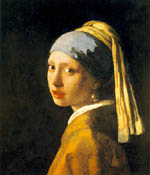



Jan Vermeer is one of these extraordinary artists that kinda disappeared from view for a while. For a while, centuries in fact, Rembrandt, Franz Hals, Jan Steen and others were examined and debated, while Jan Vermeer was little mentioned. He was considered one of the "lesser" masters of the Dutch Golden Age of Art which lasted from approx. 1600-1700. Thankfully that has all changed, and he is one of the most popular painters around Today. little wonder. His paintings are totally unique. While the style of the day was to noodle out every detail in meticulous fashion, Vermeer paints in a much looser fashion. Look at the turban this beautiful lady is wearing. The whole thing is blocked out in large shapes of shadow and light...no meticulous noodling here. Those highlights on her red lips..are just a few brushstrokes, nothing fancy, and yet the effect is marvelous. While the biggies like Rembrandt had prolific careers with literally hundreds of paintings and dozens of notable commissions, we only have about 40 paintings from Vermeer and we know virtually nothing about him, except that he was active from about 1640-1660's. Where he learned his technique is a great mystery and a lot of art historians made careers guessing...incidentally, I don't believe any of the theories at all, which is why I'm not discussing them here. The only other option is to suspect that Vermeer was a natural genius...but most art historians don't like that notion either, spontaneous intelligence happens so rarely in art history (or art historians for that matter!)
WARNING...the following section is rated PG-13!!
Another reason why I chose this image is that it illustrates a fundamental flaw with some ideas in art history. For years people had been approaching Dutch art from a purely aesthetic point of view...the "couch test" approach for those that have been following us. "How will this look over our coach?" For a long time people were content to marvel at the detail of each included item, a broom, an onion, a milking stool. Visually, it was all very satisfying. Then a new approach came about 40 years ago and swept the art history world like El Nino in California...Eblemology. The basic tack is this, that all those non-descript seemingly innocent items in dutch paintings, from potato mashers to squash, were actually charged with symbolic meaning,... deep rooted freudian repressed sexuality meaning!! For people outside the sphere of dutch art, attending a lecture on dutch art is a bit like attending a secret society of pre-adolescent girls. The lecturer points out a zucchini, or a sausage or a musical instrument, and waves of giggles and snickers roll through the crowd like a giddy rush of hormones coming over a gaggle of teenage girls at a sleep over when someone says the word "penis". (If that last statement seems a little sexist, I apologize now for brandishing my knowledge of vegetables, musical instruments and meat by-products in so insensitive a fashion) Now, I believe that the core idea of emblemology, may very well be correct, and the painter may well be trying to evoke common symbols and metaphors of the day, like domesticity, fidelity, love and even romance and physical attraction, but the notion that every violin, bottle, sausage, cucumber or any other even remotely phallic object is a secret dildo waiting to pounce upon the viewer is a little hard to swallow...this is not a pun.
Vermeer has painted his fair share of violins and vegetables in his time, and just like everybody else, people have attempted to shoehorn him into the theory of emblemology, finding sexual symbols in everything from desk globes to telescopes. But a picture like this blows...this is also not a pun... huge holes in the argument. No one to my knowledge has ever tried to evoke the turban with say...i dunno..let's say...white slavery...that is not yet, I should add. From this image, I think its very safe to say that the point of this picture is exactly what it appears to be, a pretty portrait of one of the TTMBWIAHOAT. And if that's all this picture is about, maybe we should reevaluate all those vegetable carts and cooking utensils and musical instruments in other pictures where the main figure is also, a beautiful woman. I would also like to apologize to my loyal readers who may be offended by the language I have used, but it is very difficult to get around talking about art history with terms such as "the nasty" "free willy" and "mr piddly".
Hope you come back tomorrow!
